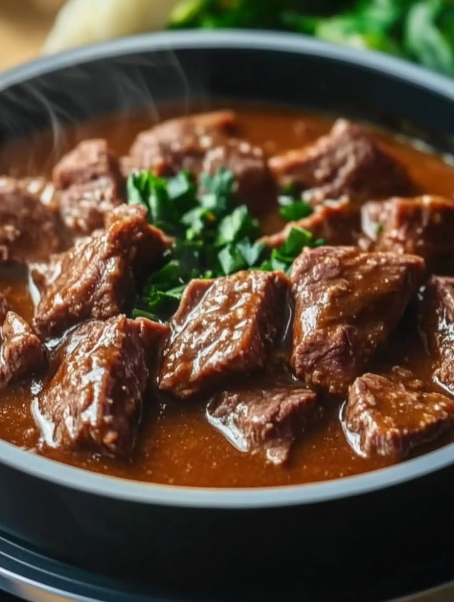What Makes Korean Beef So Special?
Korean cuisine is known for its complex, layered flavors that combine salty, sweet, and spicy notes in perfect harmony. The base of Korean beef dishes often involves ingredients like soy sauce, ginger, garlic, and gochujang, which add depth and richness to the dish. These ingredients are balanced with brown sugar or honey for sweetness and a touch of heat from gochujang (a Korean chili paste), making for a dynamic flavor profile that enhances the beef.
The use of grated pear in the marinade is a signature component in many Korean beef recipes. This ingredient not only adds a subtle sweetness but also contains enzymes that help tenderize the beef, making it more succulent and melt-in-your-mouth delicious. These unique ingredients and flavors make this Korean Beef dish a comforting yet exotic option for your dinner table.
The Role of Slow Cooking in Korean Beef
The use of a slow cooker in this recipe is a key element that brings out the full potential of the beef. Slow cooking allows the beef cubes to cook in their own juices, as well as the marinade, for hours, resulting in an incredibly tender and flavorful dish. Cooking on low heat for 8 hours or on high for 4-6 hours ensures that the meat becomes fork-tender and the flavors have time to meld together, creating a rich and satisfying sauce.
Slow cooking is particularly advantageous because it allows the flavors to develop slowly, making each bite of the beef a perfect balance of savory, sweet, and spicy. This cooking method also helps break down the tougher cuts of beef, such as those used in this recipe, turning them into a juicy, tender bite without requiring much hands-on attention.
Key Ingredients and Their Impact
Several key ingredients play a significant role in creating the distinctive flavor of this Korean Beef recipe:
- Soy Sauce: This provides the umami base of the dish, adding saltiness and a rich depth of flavor. You can easily swap it out for a gluten-free option if needed.
- Brown Sugar & Honey: These ingredients bring sweetness to balance the saltiness of the soy sauce, contributing to the dish’s signature sweet-savory taste.
- Pear: In Korean cuisine, grated pear is often used in marinades for its natural sweetness and enzyme content. It helps tenderize the beef, making it even more melt-in-your-mouth delicious.
- Garlic & Ginger: Both garlic and ginger add a wonderful aromatic quality to the dish, enhancing the overall flavor with their spicy, pungent notes.
- Gochujang: This fermented Korean chili paste adds a signature spicy kick to the dish. If you’re sensitive to spice, it can be omitted or substituted with a milder chili paste.
- Sesame Oil: A finishing touch, sesame oil imparts a toasty, nutty flavor that enhances the overall depth of the dish.
- Rice Vinegar: Adds a slight tang to balance the richness of the meat and the sweetness of the sugars, helping to round out the flavor profile.
Serving Suggestions
One of the most delightful aspects of this Korean Beef dish is its versatility when it comes to serving options. Traditionally, the beef can be served over a bed of steamed white rice or noodles. The rice soaks up the rich gravy, making for a hearty and satisfying meal.
If you’re looking to make the dish a bit lighter or add variety, you can serve the beef in soft tortillas or as a filling for tacos, topped with fresh vegetables like shredded cabbage, carrots, or cucumbers to add crunch. For a complete meal, pair it with a simple side of steamed vegetables or a green salad to balance the richness of the beef.
The addition of toasted sesame seeds and sliced green onions as a garnish brings both flavor and visual appeal to the dish. The sesame seeds provide a crunchy texture, while the green onions offer a fresh, herbaceous note that complements the deep flavors of the beef.
Health Benefits of Korean Beef
While this dish is rich in flavor, it also offers several health benefits. Here’s a breakdown of the key nutrients:
- Protein: Beef is an excellent source of high-quality protein, which is essential for muscle building and repair. Each serving of this dish contains about 47 grams of protein, making it a filling and satisfying option for any meal.
- Iron: Beef is a great source of heme iron, which is easily absorbed by the body. Iron is crucial for producing red blood cells and maintaining energy levels, making this dish an excellent option for those looking to boost their iron intake.
- Healthy Fats: While the recipe includes some fat, especially from the sesame oil, it’s mostly healthy, unsaturated fats that help promote heart health. Sesame oil also provides antioxidants that can help combat oxidative stress.
- Low Carbs: At just 11 grams of carbohydrates per serving, this dish is relatively low in carbs, making it a great choice for those following a low-carb or keto diet.
Dietary Adaptations
This recipe is highly adaptable to various dietary preferences or restrictions:
- Gluten-Free: The recipe can easily be made gluten-free by using gluten-free soy sauce (or tamari) and ensuring that the gochujang (if used) is also gluten-free.
- Spice Levels: If you’re not a fan of heat, you can omit the gochujang entirely or reduce the amount to suit your preferences. Alternatively, adding a mild chili paste can give you a touch of spice without overwhelming the dish.
- Sweeteners: For a lower-sugar version, you can reduce the amount of brown sugar or honey. Alternatively, you can use a natural sweetener like stevia or monk fruit to cut down on sugar content.
Tips for Perfect Korean Beef
- Searing the Beef: Although it’s not necessary, searing the beef before adding it to the slow cooker can add extra flavor through caramelization. This step is especially beneficial if you’re using a tougher cut of beef.
- Consistent Cooking Time: To achieve the perfect tenderness, be sure to cook the beef on low for the full 8 hours. If you’re in a rush, cooking on high for 4-6 hours will also yield delicious results, though the meat might not be quite as tender.
- Adjusting Sauce Consistency: If the sauce is too thin after cooking, you can thicken it by mixing a little cornstarch with water and adding it to the slow cooker towards the end of cooking.
- Storing Leftovers: Leftover Korean beef can be stored in an airtight container in the refrigerator for up to 3 days. It also freezes well, making it a great option for meal prep. Just reheat gently to preserve the tenderness of the beef.
Conclusion
This Korean Beef Slow Cooker Recipe is the perfect dish for those who want to explore bold flavors without spending hours in the kitchen. It combines the rich umami of soy sauce, the sweetness of brown sugar and pear, and the zesty heat of gochujang to create a balanced and satisfying meal. The slow-cooked beef is tender, juicy, and packed with flavor, making it an ideal choice for a comforting dinner that the whole family will enjoy.
Whether served over rice, noodles, or in tacos, this dish offers flexibility and versatility to cater to various tastes and preferences. With a few simple ingredients and a slow cooker, you can create a meal that feels both special and easy to prepare.






